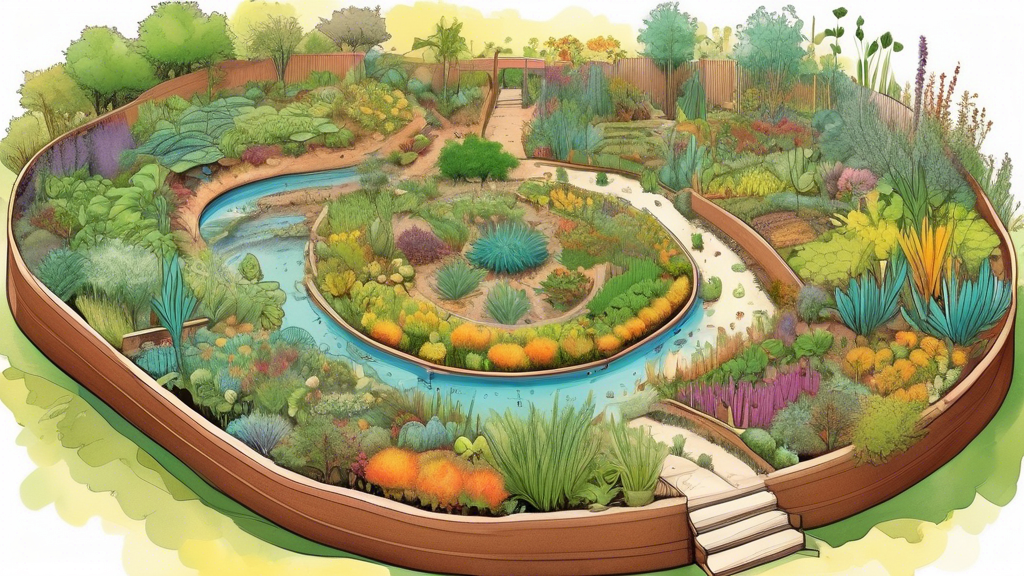Introduction
In a world grappling with increasing water scarcity, adopting
sustainable practices in our gardens is no longer just an option—it’s a
necessity. Permaculture, with its core principle of working with nature
rather than against it, offers a holistic approach to gardening that
significantly reduces water consumption while promoting thriving
ecosystems. This comprehensive guide will delve into the principles and
practical techniques of permaculture to help you conserve water in your
garden, transforming it into a haven of resilience and abundance.
Understanding Permaculture Principles for Water Conservation
Permaculture, a portmanteau of permanent agriculture or permanent
culture, goes beyond mere organic gardening. It encompasses a set of
ethical principles and design methods that mimic natural patterns to
create sustainable and self-sufficient systems. For water conservation,
the key permaculture principles include:
1. Observe and Interact
Before implementing any changes, spend time observing your garden’s
microclimate. Analyze the sun’s movement, prevailing wind patterns,
existing vegetation, and soil types. This understanding forms the
foundation for effective water management.
2. Catch and Store Energy
In permaculture, every element serves multiple purposes. Harvesting
rainwater, often wasted in conventional gardening, is paramount. This
liquid gold can be captured using various methods, such as:
-
Rain Barrels: Positioned beneath
downspouts, they collect rainwater for later use. -
Swales: Shallow trenches on contour,
they slow down and infiltrate runoff, recharging groundwater. -
Rain Gardens: Designed depressions
planted with water-loving species, they absorb and filter runoff,
preventing erosion.
3. Obtain a Yield
While water conservation is crucial, so is reaping the rewards of your
efforts. Choose a diverse range of edible and medicinal plants suited to
your climate, minimizing water-intensive species.
4. Apply Self-Regulation and Accept Feedback
Monitor your garden’s response to your permaculture practices. Observe
plant health, water infiltration rates, and any signs of stress. Adjust
your strategies accordingly, embracing the iterative nature of
permaculture design.
Practical Techniques for Water-Wise Gardening
1. Soil Improvement: The Foundation of Water Conservation
Healthy, living soil acts like a sponge, absorbing and retaining
moisture far better than compacted, lifeless dirt. To enhance your
garden’s water-holding capacity:
-
No-Till Gardening: Eschew tilling, which
disrupts soil structure and destroys beneficial organisms. -
Mulching: Apply a thick layer of organic
mulch, like wood chips or straw, to suppress weeds, regulate soil
temperature, and retain moisture. -
Composting: Enrich your soil with
nutrient-rich compost, improving its structure and water-holding
ability. -
Cover Cropping: Plant cover crops like clover
or buckwheat during fallow periods to prevent erosion, fix nitrogen,
and improve soil health.
2. Water-Wise Plant Selection: Right Plant, Right Place
Selecting plants adapted to your local climate is crucial for water
conservation. Opt for drought-tolerant species that thrive in your
region’s rainfall patterns and sunlight conditions. Consider these
water-wise planting strategies:
-
Native Plants: Indigenous species have
evolved to withstand local climate extremes, requiring less
supplemental watering. -
Xeriscaping: Embrace landscaping
techniques that minimize water use. Group plants with similar
watering needs, and prioritize drought-tolerant options. -
Succulent Gardens: Succulents store water
in their leaves or stems, making them ideal for arid climates. -
Mediterranean Herbs: Lavender, rosemary,
and thyme are not only aromatic but also drought-tolerant, adding
fragrance and flavor to your water-wise garden.
3. Efficient Irrigation: Watering with Precision
Even in water-wise gardens, supplemental irrigation might be
necessary during prolonged dry spells. However, it’s crucial to water
efficiently to minimize waste:
-
Drip Irrigation: Delivers water slowly
and directly to plant roots, minimizing evaporation. -
Soaker Hoses: Porous hoses laid beneath
mulch seep water directly into the soil, reducing runoff. -
Water Deeply and Less Often: Encourage
deep root growth and drought tolerance by watering deeply but less
frequently. -
Water in the Morning: Reduces water
loss through evaporation compared to midday or evening watering.
4. Water Harvesting: Catching and Utilizing Rainfall
As mentioned earlier, capturing and storing rainwater is a cornerstone
of permaculture water conservation. Beyond rain barrels and swales,
consider these additional harvesting methods:
-
Green Roofs: Install a living roof planted
with drought-tolerant species to absorb rainwater, reduce runoff,
and insulate your home. -
Permeable Paving: Choose permeable
materials like gravel or pavers with gaps to allow water to seep into
the ground, replenishing groundwater.
5. Greywater Systems: Repurposing Used Water
Greywater, the gently used water from sinks, showers, and washing
machines (excluding toilet water), can be a valuable resource in
water-scarce areas. However, it’s essential to use it safely and
responsibly:
-
Greywater Diverters: Direct greywater
from specific sources to designated irrigation areas. -
Greywater Treatment: Implement basic
filtration and treatment methods to remove soap and other
contaminants before irrigation. -
Use on Non-Edible Plants: Avoid using
untreated greywater on edible plants or in areas where children
or pets play.
The Benefits of Water Conservation in Your Permaculture Garden
Adopting permaculture principles for water conservation in your garden
yields numerous benefits:
1. Environmental Stewardship
By reducing your reliance on municipal water and minimizing runoff, you
contribute to conserving precious water resources, protecting local
ecosystems.
2. Financial Savings
Reduced water bills are a direct benefit of water-wise gardening.
Furthermore, investing in permaculture practices like composting and
mulching often saves money on fertilizers and weed control in the
long run.
3. Healthier Plants and Soil
Permaculture techniques promote healthy, vibrant soil that retains
moisture and nutrients, leading to healthier, more resilient plants
better equipped to withstand drought.
4. Reduced Garden Maintenance
Water-wise gardens often require less frequent watering and weeding,
freeing up your time to enjoy the fruits of your labor.
Conclusion
Water conservation through permaculture is not about deprivation;
it’s about creating a thriving, resilient garden that works in harmony
with nature. By embracing these principles and techniques, you can
transform your garden into a model of sustainability, conserving
water, supporting biodiversity, and enjoying the abundance that
follows.


